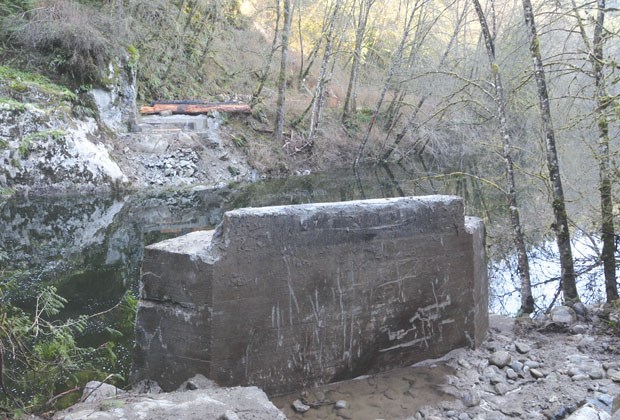The Twin Bridge that once spanned the Seymour River and was a popular connection for trail users is no more.
The bridge had been closed since the Dec. 7 rock slide that caused the river to begin pooling until some of Metro Vancouver’s staff were calling the body of water a new lake.
Contractors removed the bridge this week after geotechnical experts and engineers advised it was “completely substandard,” said Bob Cavill, Metro Vancouver watershed division manager.
As of Wednesday, the level of the water was well below the old bridge deck but it continues to rise and fall dramatically based on rainfall and, to a lesser extent, settling of the boulders from the rock slide, Cavill said. Even with the variances, the bridge had to go.
“The depth of the river is far deeper than it’s ever been in recorded history. The bridge was designed for a much different river than what exists there now,” he said.
Engineers contracted to remove the bridge did so in such a way that it could be kept intact and stored for possible reuse down the road (or river), Cavill said.

District of North Vancouver Fire and Rescue Services members are being briefed on the new dangers the body of water will present to adventurers who are tempted to treat it as a new swimming hole when warm weather arrives.
As it stands right now with unstable banks, falling tree snags, and unpredictable water flow, the area remains dangerous, Cavill said.
“Until we get a better handle on just how that new piece of gorge responds to intense rainfall events and that type of thing, our advice will be to just stay away from the area,” he said.
The exact implications for future salmon runs still aren’t known as the boulders have created a likely fish barrier, but the Seymour Salmonid Society and Department of Fisheries and Oceans are looking into options.
That may include a tagging program or possibly a trap-and-truck system to get the fish to their spawning grounds.

Metro staff are also still trying to figure out the long-term plan for the trails lost to flooding. The Fishermans’ Trail on the east side of the river remains closed, as does the connecting Bottle Top Trail.
“I don’t think there will be an early decision on trail connectivity but we’re the maintainer of those trails. We have a vested interest and we’ll look at whatever options are available down the road,” he said.
Though the rock slide, bridge and trail network are mainly all within Metro’s jurisdiction, District of North Vancouver Mayor Richard Walton said Friday he would like to see the bridge replaced.
“We want that bridge back, if not there, we want a way for folks to get across. That’s a critical link in the recreational trail system,” he said.
Because the water still flows, it’s technically not correct to call it a lake, Cavill said, and the appropriate term would be “pondage.”
As for what to call the pondage: “We haven’t turned our mind to it,” Cavill said.



